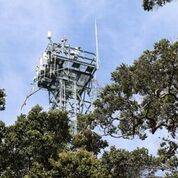PUU MAKAALA NATURAL AREA RESERVE — The Puu Makaala Natural Area Reserve in Mountain View on Hawaii Island has a new tallest point — a 105-foot-high meteorological tower with millions of dollars of high-tech sensing equipment attached to it.
The tower is the final component of the National Ecological Observatory Network, or NEON. Funded by the National Science Foundation and operated by Battelle Memorial Institute, it’s a system of 81 field sites spread across the entire country with the final tower recently completed in Hawaii and now online, the Department of Land and Natural Resources announced in a press release.
Each site collects standardized data from automated sensors, airborne remote sensing surveys and on-the-ground observational sampling by field scientists, the release continued.
The terrestrial, aquatic and atmospheric data and samples collected at these sites are available to scientists, and anyone else interested, through a single, openly accessible data portal.
NEON is expected to generate data for ecological research over the next 30 years, DLNR said.
“The idea of NEON is to create a giant data clearinghouse where anyone can go to the web and access data from Alaska, Hawaii, Puerto Rico and every state and see continental-scale changes for the next three decades,” said Michael Long, field operations manager for NEON in Hawaii. “It’s available to researchers, students, to anybody and we hope it will get people excited about science as they see the types of measurements and the types of data that we can collect and how it connects to the environmental changes we see around us.”
Data collection instrumentation on the observatory includes a net radiometer, photoactive radiation sensors, rain samplers, CO2 gas systems, carbon flux sensors and tipping buckets, among several others, the release stated.
“A huge benefit of NEON is there are guaranteed, standardized protocols to measure everything here in Hawaii exactly the same way it’s being measured across the nation,” said Robert Hamnett, senior field ecologist for NEON in Hawaii. “There’s never been anything like it.”
The automated sensors on the tower in Puu Makaala Natural Area collect weather and climate data from above the tree canopy and down to the ground. Additional sensors in the ground collect soil health data. The NEON field scientists in Hawaii also collect routine observations of birds, insects, soils, and plants to monitor changes in traits and populations dynamics, the release explained.
The rich data emanating from NEON will be beneficial for land managers and researchers working in the Puu Makaala Natural Area Reserve, the release contended.
Currently, 13 different data sets are available for download from the NEON Hawaii field site, but that number is expected to grow exponentially over time, DLNR said.
Hawaii’s NEON site will be the only one here. Other states have multiple field sites, some of which can be relocated.



